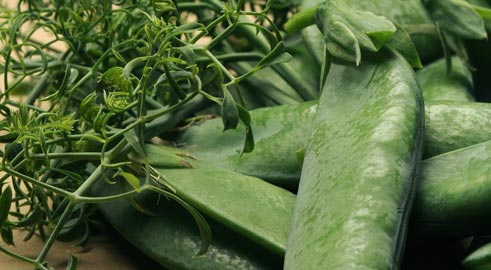 The frilly tendrils of Masterpiece pea are deliciously edible, as are the pods.
The frilly tendrils of Masterpiece pea are deliciously edible, as are the pods.
© National Garden Bureau
If you’re tired of planting the same old green beans and tomatoes, how about trying something new?
Asian vegetables, such as tatsoi, daikon and mizuna, may sound exotic but they are as easy to grow as greens and radishes. And then there’s that trendy pea, Masterpiece, whose tendrils are as tasty as the pod.
You might be able to find transplants at garden centers or from online retailers, but more than likely, you’ll need to sow seeds right in the garden for these veggies. That means you can sow seeds every few weeks to ensure a much longer, delicious harvest. Here are some tips to get you started.
 Mizuna adds a mild, peppery flavor to a mixed green salad and stir-fries.
Mizuna adds a mild, peppery flavor to a mixed green salad and stir-fries.
© National Garden Bureau
Tatsoi forms a tight clump, or rosette, of leaves on a compact plant. Pick a sunny to partly sunny spot and sow these mustard seeds after the last frost date in spring and every couple of weeks through midsummer. Harvest baby leaves after about 25 days. The plant will reach maturity in about 45 days. Tatsoi, a member of the cabbage family, adds a mild, mustard flavor to salads, stir-fries and other dishes.
Want a fancy radish? Daikon is it. This root vegetable, in the same family as cabbage, resembles a fat carrot. Unlike its round, red cousins, the elongated or slightly rotund daikon has sweet, crisp flavor. It can be pickled, sliced for salads or used in stir-fries. Grow in loose, organically rich soil in a sunny spot. Sow seeds in March and April and harvest plants about 55 days later. Sow a second crop mid August to mid September.
Another member of the cabbage family, mizuna is a Japanese mustard with slightly frilly, serrated leaves. Chop the leaves for a mild, peppery flavor in salads, or sauté for a side dish or use in stir-fries. Sow seeds in a sunny spot in April and harvest 30-45 days later. Sow again in August for late-season greens.
Lastly, make room for Masterpiece pea, with fancy, parsley-like, edible tendrils, and pods that can be eaten as is or shelled. Twenty-four days after sowing seeds in March and April, you can harvest the leaves. Wait 60 days and harvest the pods. Sow again in August. Masterpiece’s cascading form and smaller size makes it perfect for a sunny window box or pot.
by Jo Ellen Meyers Sharp